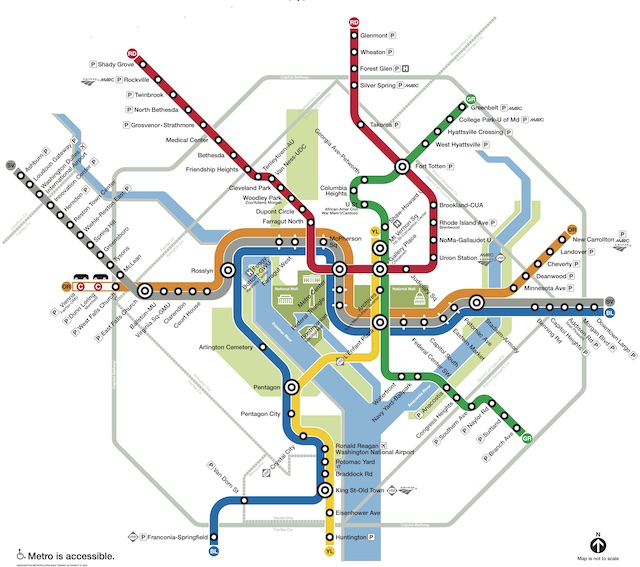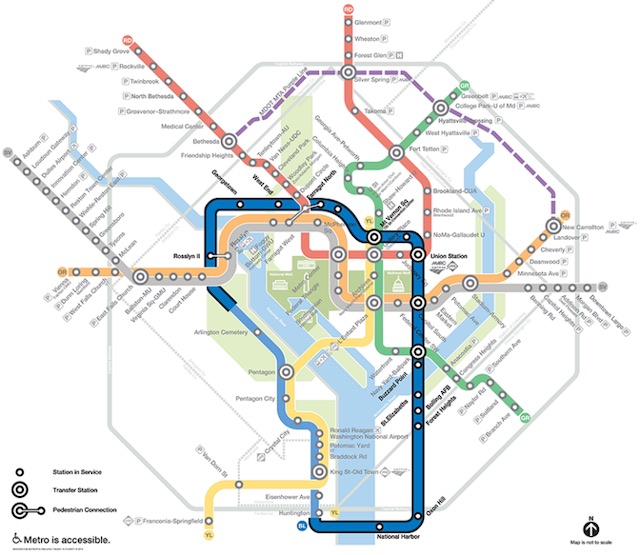Like San Francisco BART, the DC Metro rail system is facing a fiscal cliff, with a $750 million projected shortfall in operating funds in 2025. So why is the agency considering spending tens of billions of dollars on a new rail extension that will increase annual operating costs by $200 million?
For a mere $40 billion or so, DC Metro Rail can go from this. . .
Like BART, DC’s rail system historically has covered a high percentage of its operating costs with fares. Though that has declined from 68 percent in 2011 to 48 percent in 2019, the agency was still more vulnerable to ridership declines than agencies such as San Jose’s VTA, which before the pandemic covered less than 10 percent of its operating costs out of fares.
. . . to this.
Also like BART, DC rail was hit extra hard by the long reach of COVID, with ridership at last report still less than half of pre-pandemic levels. So, with ridership down, apparently permanently, and future funding uncertain, what’s a transit agency to do? Why, build more rail, of course.
Blame W, that is to say, George W. Bush. After extensive analysis, his transportation secretary, Mary Peters, had concluded that bus rapid transit to Dulles Airport made more sense than rail. At the instigation of Virginia senators, Bush overruled her and ordered the Federal Transit Administration to fund rail to Dulles. The Virginia senators also persuaded Congress to exempt the Dulles line from Peters’ strict cost-effectiveness rule, which said that the FTA would not fund expensive projects that were projected to produce little benefits (which was another parallel with BART, as Congress also exempted the BART line to San Jose from this rule).
Virginia senators didn’t care about travelers to Dulles Airport. Instead, the new rail line would be a multi-billion-dollar gift to the developers of Tysons Corner, who had been told by Fairfax County that local highways wouldn’t support any new construction in their part of the region. They thought that a rail line would fix that. As it turned out, the county later concluded that not enough people would ride the trains to justify more development, but they let the developers build more anyway as a reward for supporting transit rather than roads.
The problem was that the Silver line, as the Dulles line is now called, shares subway space between Rosslyn, Virginia and eastern DC with the Blue and Orange lines, and DC subways allow no more than 26 trains per hour. The Blue line in particular was operating at capacity during rush hour, so when the Silver line opened and its trains were not filled to capacity, every Blue line train that was cut to make room for a Silver line train meant the system lost riders. That’s one of the reasons, though not the only one, that Metro rail ridership dropped by 12 percent between 2014, when the Silver line opened to Tysons, and 2019.
Metro proposes to fix this problem by extensively rebuilding the Blue line. Most important, Metro wants to build a new subway under the Potomac and parallel with the Orange and Silver lines, which would share the existing tunnel.
One of the flaws in this plan is that it is a kludge, by which I mean the new Blue line is not a carefully planned part of the Metro system as a whole. Instead, it has been hastily drawn so that most of the DC portion essentially duplicates existing lines. Except for a stop in Georgetown, all of its stops are either already covered by other rail lines or they are within a block or so of other rail stops. Thus, billions would be spent for few new riders.
To make the proposal appear to be truly expansive, Metro proposes to turn the Blue line into a loop going into Prince Georges County and crossing the Potomac a second time before it rejoins itself in Alexandria. What’s wrong with that? Apparently, “it’s too expensive” isn’t an answer transit people understand.
This plan should have been rendered moot by the pandemic. Although the Potomac tunnel’s capacity is 26 trains per hour, ridership is so low that Metro is currently running only 16. It would like to increase that to 20, but doesn’t have the funds (meaning the ridership) to do so. If the Blue line is no longer running at capacity, there’s no problem to be solved, right?
Wrong: the problem today is that Congress is being extraordinarily generous with funds for new transit projects, and if Metro doesn’t get on the ball, it will lose out on “it’s share” of the funds. It doesn’t matter that the project is no longer needed. It doesn’t matter that, even if ridership increases by 50 percent from current levels, the capacity problem no longer exists. What matters is to get as many of those free federal dollars as possible.










I thought they were herbivores but RINOs like pork too
In Chicago, Metra now carries a fraction of 2019 passengers and teeter towards a huge fiscal cliff. Solution? Let’s go to Rockford!
Of course it can’t be a start small and build in to demand. No. All stations have to be ADA compliant and have huge platforms and paved parking lots.
Is there really that much demand for Chicago to Rockford train service? I doubt it. That Illinois itself teeters on a fiscal cliff and should be cutting outlays is irrelevant to those who want the taxpayers to subsidize their hobby.
The boondoggles keep coming.
They don’t enforce rules against “fare jumping”; the beep alarm of someone forcing the turnstile open is now a common sound at the WMATA stations.